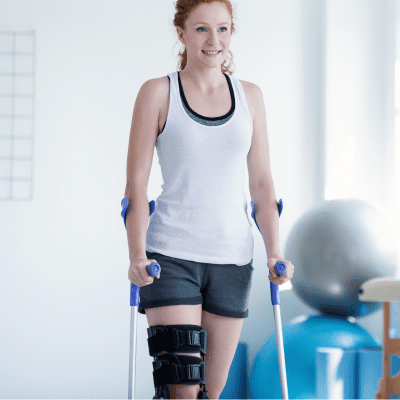Living with Ehlers Danlos Syndrome (EDS) can be a relentless battle against chronic pain and debilitating symptoms. But what if there were more effective treatments available, waiting to be discovered? In this article, we delve into the realm of treatments for EDS, exploring the latest breakthroughs and methods to alleviate symptoms and improve quality of life. I highlight my favorite products that have allowed me to successfully navigate daily living with EDS.
Understanding the complex nature of EDS is key to finding effective treatments. EDS is a group of genetic disorders that affect the connective tissues in the body, resulting in hypermobility, joint pain, and fragile skin. While there is currently no cure, there are promising treatments that can offer relief and slow down the progression of the condition.
Treatments for EDS and associated pain typically involves a multidisciplinary approach. From physical therapies and orthopedic interventions to medication and lifestyle changes, we uncover the most effective strategies for managing EDS symptoms. We also delve into emerging therapies, such as regenerative medicine and genetic interventions, which hold great potential for transforming the lives of those affected by EDS.
If you or someone you know is living with EDS, join us on this journey as we unlock the secrets to effective treatments and bring hope to those battling this challenging condition.
This post contains affiliate links, which means I may receive a commission if you make a purchase using these links. There is no increase in price by going through our links. These are also products I personally use.
What is Ehlers-Danlos Syndrome (EDS)?
Ehlers-Danlos Syndrome (EDS) is a group of genetic disorders that affect the connective tissues in the body. Connective tissues provide support and structure to various organs, joints, and skin. In individuals with EDS, the connective tissues are abnormal, leading to a range of symptoms and complications.
Common symptoms of EDS
EDS presents a wide array of symptoms that can significantly impact an individual's quality of life. Some common symptoms include joint hypermobility, joint pain and dislocations, skin that is easily bruised or stretches excessively, and fragile blood vessels. People with EDS may also experience chronic fatigue, digestive issues, and cardiovascular problems. You can check out our other blog post to learn more about what it’s like living with Ehlers Danlos Syndrome
The severity and specific symptoms vary depending on the type of EDS an individual has. Some individuals may have milder symptoms and be able to lead relatively normal lives, while others may experience debilitating pain and require ongoing medical care.
Traditional Treatments for EDS
While there is currently no cure for EDS, there are traditional treatment options available to manage symptoms and improve quality of life. These treatments aim to address specific symptoms and complications associated with EDS. I have Ehlers Danlos Syndrome Hypermobility Type. Therefore, I will highlight the treatment strategies that have been the most beneficial for me personally below. Every person's journey is different, but I hope you find this comprehensive list useful. Common traditional treatments include:
1. Physical therapy: Physical therapy plays a vital role in managing EDS symptoms. It focuses on strengthening muscles, improving joint stability, and enhancing overall physical function. Physical therapists may also provide guidance on proper body mechanics and joint protection techniques. Physical therapy appointments have helped tremendously in protecting my joints, getting familiar with what proper range of motion is instead of going past the norm, and strengthening muscles to ward off instability.
There are several products I use at home for my physical therapy exercises. This isn't a complete list by any means, but I highlight some of my favorite products that I use the most.
I use the THERABAND Resistance Bands Set at home for light strength training exercises assigned by my physical therapist.
Foam rolling can help release muscle tension and reduce muscle tightness, which is often seen in individuals with EDS due to compensatory movements and joint instability. Gently rolling over affected areas can alleviate muscle knots and discomfort.
I have been obsessed with this Bosu Balance Board since I bought it years ago. I can use it for proprioception (your body's sense of where it is in space), stability and strength training.
I use this Theracane for targeting and relieving muscle tension and knots in hard-to-reach areas of the body, such as the upper back, neck, and shoulders, providing a deep and effective form of self-massage and trigger point therapy.
2. Joint support: Proper joint support is essential to reduce the risks associated with joint instability and maintain a good quality of life for individuals with EDS. Hypermobility can increase the possibility of joint dislocations, subluxations (partial dislocations), and sprains. Joint support is highly individualized as each person with EDS will need different support from the next.
There are a lot of products that can increase joint stability depending on body area (i.e. knee, shoulder, wrist, fingers, etc). There are many more options, but I am highlighting a few of my favorites.
I am using this Push Brace as I am typing. It helps alleviate thumb pain by keeping the thumb in a safe range of motion instead of allowing it to hyperextend.
I use ring splints everyday so that I don't hyperextend my fingers. They help tremendously with pain. I actually went through the Silver Ring Splint company and got custom ring splints through my physical therapist. But these are pretty close to what I have.
I have flat feet with no arch to speak of, which is typical of EDS. Shoe inserts are a must for me to create some arch support, which helps support the joints from the feet up.
3. Pain Management: Pain management is a critical topic in treating Ehlers-Danlos Syndrome (EDS) because individuals with EDS often experience chronic and debilitating pain as a result of joint hypermobility, tissue fragility, and associated complications. Chronic pain significantly impacts quality of life, daily functioning, and mental well-being. Effective pain management strategies, including medications (i.e. tylenol, low dose naltrexone, and ibuprofen among others), physical therapy, and lifestyle modifications, are essential to alleviate suffering, and improve mobility. Furthermore, these products enhance the overall well-being of individuals with EDS, allowing them to lead more fulfilling lives despite the challenges posed by the condition. I could write pages and pages of my favorite products, but I will leave you with several for now.
Epsom salt is an inexpensive, effective way to treat sore muscles, while promoting deep relaxation to reduce stress. Add two cups of epsom salt into a full bath of water and soak for 15-30 minutes, then rinse off afterwards. Make sure you are well hydrated when taking epsom salt baths.
Cupping therapy is a traditional alternative medicine practice that involves placing cups, typically made of glass or silicone, on the skin to create suction. It's an invaluable tool for me in pain management. It increases blood flow, relieves muscle tension and reduces inflammation. It's important to have cupping done by someone who is professionally trained. I will also be highlighting how to use a cupping set in a future blog post.
Oh, massage gun, how do I love thee! This mini massage gun is a life saver. I like the mini one over the standard size because it's lighter and I can take it with me when I travel. This is great for trigger points, knots, sore muscles and for overall relaxation.
Gua sha is a traditional Chinese therapy that involves lightly scraping the skin with a gua sha tool. It stimulates blood flow, lowers inflammation and relieves muscle tension. I will be highlighting how to properly use a gua sha tool in future blog posts.
Ok, so admittedly this is a splurge item. This Kahuna Massage Chair has been a game changer for pain relief and relaxation. It's got a heating option and various massage types to choose from. It's incredibly helpful in relieving sore muscles. It's a favorite in my household!
This TENS Unit (Transcutaneous electrical nerve stimulation) can alleviate pain by lowering the pain signals going to the brain, increasing blood flow and by reducing inflammation. One word of caution, if you have an adhesive allergy, it's important to find electrodes for sensitive skin to pair with the TENS unit.
When there's a fresh injury (I'm talking about you, dislocated and torn tendons!), ice packs are a necessity for pain relief and to reduce inflammation. These ice packs are worth their weight in gold. I have an entire section in my freezer filled with ice packs of varying sizes to have at the ready.
I am partial to a larger heating pad as I feel like it offers a little more flexibility in its uses. I like to use this when my muscles are tight from working overtime and need a reprieve. It helps with circulation and relaxation.
4. Assistive Devices: Assistive devices can be invaluable for someone with hypermobility, as they provide crucial support and enhance daily functionality. Devices such as reacher/grabber tools, walkers, or household assisting products offer support for every day activities. These assistive devices empower individuals with EDS to navigate their daily lives with greater confidence, independence, and reduced discomfort.
This Grabber tool has come in handy when i've had herniated discs or post surgery and cannot, for the life of me, bend over to pick something up. You'll quickly realize how much bending you do each day when you can't for whatever reason.
I have this jar opener mounted under my cabinets in my kitchen. It works like a charm with very little effort on my part. My fingers are spared the agony of wrestling with a jar to open it.
This is the can opener I have that makes opening up any can a breeze. You just press a button and let it make its round around the can.
5. Ergonomic Tools: Ergonomic furniture is of utmost importance for patients with EDS as it can significantly enhance their daily comfort and well-being. Ergonomic furniture, such as specially designed chairs and desks, can offer proper support and alignment, reducing the strain on joints and muscles. This not only helps alleviate discomfort and pain but also promotes better posture and overall health. By creating an ergonomically friendly environment, individuals with EDS can enjoy increased productivity and a higher quality of life, allowing them to better manage their condition. These are a few of the products that are useful to me allowing me to work more comfortably.
The Steelcase Series 1 Office Chair isn't your run-of-the-mill office chair where your butt is numb after 30 minutes. I can sit in this chair for an extended amount of time without feeling every joint in my body. I used to work for Steelcase a long, long time ago now, but I know what quality furniture they have. Trust me, your body will thank you.
This bed wedge was a game changer for me when I had a flare up issue with a herniated disc in my back. It helps elevate the upper body, reducing the risk of joint strain and improves breathing, particularly for those with gastroesophageal reflux or breathing difficulties. Sleep on it when you have a cold or sinus infection and you'll be less likely to get nudged for mouth breathing and snoring.
We all know how important sleep is for overall health. This Tempur Pedic Mattress topper has saved my muscles and joints from pressure points while sleeping. Before I got my mattress topper, I woke up feeling like I was run over by a truck, achey, tired and certainly not well-rested. I quickly realize when I am sleeping somewhere else how much I miss my gel mattress topper.
6. Orthopedic Surgical Intervention: Orthopedic surgical interventions are sometimes necessary for individuals with EDS to address severe joint instability and chronic pain that cannot be effectively managed through non-surgical means. These procedures may involve joint stabilization, ligament and/or tendon repair, helping to improve functional mobility and overall quality of life for individuals living with EDS.
7. Build a Healthcare Team: Forming a knowledgeable and compassionate healthcare team is paramount when living with EDS. Such a team can provide essential guidance, tailored treatment plans, and emotional support, helping individuals navigate the challenges of their condition with care and expertise.

Alternative Therapies
1. Mind-Body Practice: Mind-body techniques offer valuable strategies to lower pain and relieve stress, benefiting both physical and emotional well-being. Practices like meditation, deep breathing exercises, and progressive muscle relaxation help individuals with chronic pain, by promoting relaxation and reducing muscle tension. These techniques can also modulate the perception of pain, making it more manageable. Additionally, they empower individuals to better cope with the emotional toll of chronic pain and stress, fostering a sense of calm and resilience in the face of adversity. Integrating these practices into daily routines can significantly improve the overall quality of life for individuals seeking relief from pain and stress. I use the Insight Timer app for meditation as it's easy to use without any experience and it guides you through meditating step-by-step.
2. Tai Chi involves a series of slow and flowing movements or poses, often referred to as “forms,” that are performed in a meditative and focused manner. Tai chi emphasizes deep breathing, relaxation, and mindfulness as you move through a sequence of postures, transitioning smoothly from one to the next. It is practiced for its many health benefits, including improved balance, strength, stress reduction, and overall well-being. Tai chi is suitable for people of all ages and fitness levels and is often practiced for both its physical and mental benefits. I suggest looking on youtube to find some Tai Chi videos because they are a matter of personal taste.
3. Biofeedback involves using electronic monitoring to help individuals gain awareness and control over physiological functions like heart rate, muscle tension, and skin temperature. It can be used to reduce stress, manage pain, and improve overall health and wellness. You can search for a practitioner in your area through the Biofeedback Certification International Alliance.
4. Hydrotherapy involves the use of water for therapeutic purposes. Soaking in warm water or participating in aquatic exercises can help reduce joint pain, improve proper mobility, and promote relaxation.
5. Acupuncture can offer relief to individuals with Ehlers-Danlos Syndrome (EDS) by helping to manage pain, reduce muscle tension, and improve overall well-being. The insertion of fine needles into specific acupuncture points stimulates the body's natural healing processes, potentially providing relief from chronic pain and promoting relaxation.
6. Massage therapy can help relieve muscle tension, reduce pain, and improve circulation. It is important to work with a massage therapist who is familiar with EDS and can adapt their techniques to accommodate the unique needs of individuals with the condition.

Emerging Treatments for EDS
In recent years, there have been exciting developments in the field of EDS treatment, offering hope to individuals living with the condition. Emerging treatments focus on addressing the underlying genetic mutations and enhancing the production and function of collagen. Some promising emerging therapies include:
1. Regenerative medicine: Regenerative medicine aims to stimulate the body's natural healing processes to repair and regenerate damaged tissues. Stem cell therapy, growth factor injections (as seen in prolotherapy injections), and tissue engineering techniques hold great potential for restoring normal collagen production and improving connective tissue function in individuals with EDS.
2. Genetic interventions: With advancements in genetic research, gene therapy and gene editing techniques are being explored as potential treatments for EDS, although they do not currently exist. These interventions aim to correct the genetic mutations responsible for EDS, potentially providing a long-term solution to the condition. Continued research and clinical trials are essential for furthering our understanding of EDS and developing more effective treatments.
Support Groups & Resources for Individuals with EDS
Living with EDS can be challenging, both physically and emotionally. Connecting with others who understand the unique experiences and challenges of EDS can provide invaluable support. There are numerous support groups and resources available for individuals with EDS and their families, both online and in-person. These groups offer a platform for sharing experiences, finding support, and accessing valuable information about EDS management and treatment options.
Additionally, nonprofit organizations dedicated to EDS advocacy and research, such as the Ehlers-Danlos Society, provide a wealth of resources, educational materials, and opportunities for participation in research studies.

Hope for Individuals with EDS
Living with Ehlers-Danlos Syndrome can be incredibly challenging, but there is hope. While there is currently no cure for EDS, effective treatments and management strategies are available to alleviate symptoms and improve quality of life. From traditional treatments and emerging therapies to lifestyle modifications and alternative therapies, individuals with EDS have a range of options to explore.
By staying informed, seeking support, and working closely with healthcare professionals, individuals with EDS can unlock the secrets to effective treatments and find hope in their journey towards managing this complex condition. Together, we can continue to raise awareness, promote research, and improve the lives of those affected by EDS.






















